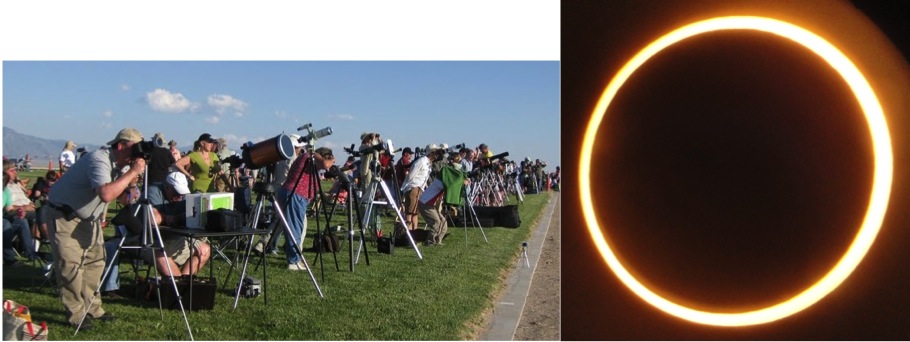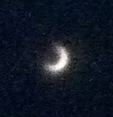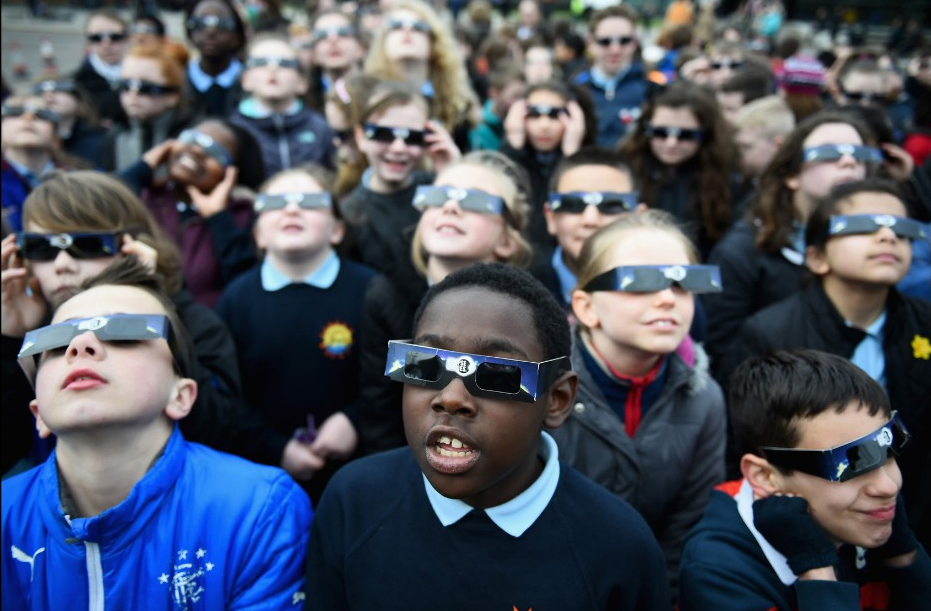You may have heard that there’s a total solar eclipse happening on Monday. I have known about this event for at least five or six years, which is how long my dad has been planning for it. Dad already had me pretty excited for the eclipse, but after reading David Baron’s delightful book, American Eclipse, and interviewing him for our FiveThirtyEight science podcast, I’m all in. (Listen to Baron’s Story Collider or TED talk, and you’ll have eclipse fever too.) I’ll be meeting up with Dad and Mom and numerous friends in Casper, Wyoming to witness two minutes and 26 seconds of totality. In advance, I called up my dad to get some last minute thoughts.
CHRISTIE: Why is this eclipse such a big deal?
DAD: Well, number one, it goes all the way across the U.S., so a large part of the country is eligible to see it. Two, it’s a mid-day event, so people don’t have to get up early or stay up late to see it. Social media has helped it get much more publicity than it might have had in the past, and many more people are taking advantage of this to make money and all that.
It’s also an event of the universe outside of our political world. There’s nothing controversial about it; nothing not to like about it. And so many people live within a three hour drive of totality.
CHRISTIE: What’s your plan for watching?
DAD: I’m going to find a spot to wait for it under some trees where it’s cool. I will bring my little telescope with an oil-filtered eye piece that can project an image so that five or six people can see it.
CHRISTIE: Is this a chance for the U.S. to come together and be a little less divided?
DAD: Yes, for a little while. It definitely can bring people together. Then people will go back to their lives. To most people, it’s a nice event, but it won’t last.
CHRISTIE: Wow, that’s a more cynical answer than I was expecting.
DAD: I think it’s a realistic view. It doesn’t mean it can’t or won’t unite people, but it’s not going to move the bases. A small percentage of people will go away thinking differently, but in the scheme of life of it’s not going to change everything. Sorry, but that’s what it is. Science marches on.
CHRISTIE: I’ve been hearing some people here in Colorado say that they’re in the 90 percent zone, and that’s good enough. How would you convince them it’s worth traveling to the path of totality?
DAD: The best explanation I’ve heard is from Barry Gorden, who was a member of our astronomy club. He said that the difference between an partial and total eclipse is 100 percent. You’re comparing an apple and an orange.
CHRISTIE: This will be my first total eclipse. You?
DAD: I’ve seen an annual and a number of partial ones but never a total eclipse — most people have not. Usually, if you want to see one, you have to pay lots of money and travel halfway around the world.
CHRISTIE: I’m convinced. I hope our LWON readers are too. But just in case, let’s revisit our conversation from the 2012 annular eclipse.
The following post first ran on May 22, 2012, but with the total solar eclipse coming up on Monday, it’s relevant again.
 I have been hearing about Sunday’s annular eclipse for weeks. Earlier this month, I visited my parents in Albuquerque, and the eclipse was all my dad could talk about. Dad, known to the rest of the world as Dee Friesen, is President of the Albuquerque Astronomical Society (TAAS) and when I arrived at his house the other day, he was wearing a t-shirt with the words “Astronomy (not astrology)” written across the chest in big letters.
I have been hearing about Sunday’s annular eclipse for weeks. Earlier this month, I visited my parents in Albuquerque, and the eclipse was all my dad could talk about. Dad, known to the rest of the world as Dee Friesen, is President of the Albuquerque Astronomical Society (TAAS) and when I arrived at his house the other day, he was wearing a t-shirt with the words “Astronomy (not astrology)” written across the chest in big letters.
During the course of my four day visit, Dad managed to get me pretty excited about the eclipse. Albuquerque was inside the zone where the eclipse was visible in its entirety, and it was also about 90% visible in western Colorado, where I watched it from my front yard.
After it was all over, I called Dad with some questions.
CHRISTIE: What made this eclipse special?
DAD: Several things. In Albuquerque the centerline of the moon’s shadow crossed right through the airport. It was one of the best locations to view the event. The second reason is because it was an annular eclipse. This produces the “ring of fire” image in place of the total blocking of the sun’s disk.

CHRISTIE: It was really tempting to try peeking directly at the sun with my sunglasses on, but I decided to obey my father and use a pinhole viewer. Dave made one from an empty case of wine.
DAD: Were you able to see after you drank a case of wine? Thanks for being a good daughter and protecting your eyes.
CHRISTIE: It doesn’t sound very exciting to turn your back to this big show and watch it on the bottom of a cardboard box, but I have to say, it was really cool! Even though it’s just a tiny dot through the pinhole, it was spectacular. It looked just like what I would expect to see through a telescope, only a little smaller.
DAD: Yes, actually experiencing the celestial event is truly exciting–you realize that at the moment you view the eclipse, the moon and the sun (our star) are perfectly aligned in a straight line. How you obtain that view is a secondary issue. Even if you try to take photographs, there will always be much better pictures available on the internet.
CHRISTIE: I loved that it just went on and on. We had three of us watching and we didn’t have to fight over the viewer. I drank almost an entire beer before it was over. It was the perfect Sunday afternoon event. Leisurely, yet engaging.
DAD: No beer for us since it was a public family event sponsored by Bernalillo County. However, there was a very relaxed festive atmosphere. The Albuquerque Astronomical Society had a number of telescopes with solar filters for viewing of the multiple sun spots as well as flares and prominences on the surface of the sun. We also had a special education display explaining the simple physics of an eclipse. People really took the time to listen and hopefully gained an understanding of the science of the eclipse.
CHRISTIE: As it got closer and closer to its maximum, I felt myself getting all giddy with anticipation. When it was at its peak, we fell into a sort of awe.
 DAD: I have been to a lot of public sky viewing events, but nothing compares to this. At a typical event, timing is not a factor. However, during the eclipse, everyone views the same objects at the same time. As the event proceeded, anticipation built in the crowd and a large chorus of cheers erupted at the first moment of annularity.
DAD: I have been to a lot of public sky viewing events, but nothing compares to this. At a typical event, timing is not a factor. However, during the eclipse, everyone views the same objects at the same time. As the event proceeded, anticipation built in the crowd and a large chorus of cheers erupted at the first moment of annularity.
CHRISTIE: The eclipse happened near sunset, but the quality of the light during the eclipse seemed different from a normal sunset. The light appeared kind of gray and the shadows were really sharp.
DAD: That is what happens as the intensity of the sun gets dimmer. It is like an old time film projector that has a dim projection bulb. The shadows appear sharper because the light source, in this case the sun, gets smaller and is more of a point source.
CHRISTIE: How many people showed up at the TAAS events to watch?
DAD: We are still trying to find out. TAAS was represented at four different locations. The total count will exceed 10,000. In addition, we had several members who went to a parks unannounced and had an unexpected 100 people join them for viewing.
CHRISTIE: The eclipse wasn’t scientifically significant, so why did it matter?
DAD: People were actually thinking about their location in the universe. They looked outside their televisions and smart phones and air-conditioned houses, and observed the natural world. For a few hours on a Sunday afternoon, people forgot about everything else except their moon and their sun. Most importantly, they enjoyed it.
***
Photos: Kids watching the eclipse, NASA. Eclipse watchers and ring of fire courtesy Dee Friesen. I took the small eclipse photo with my iphone, pointed into the pinhole viewer.
